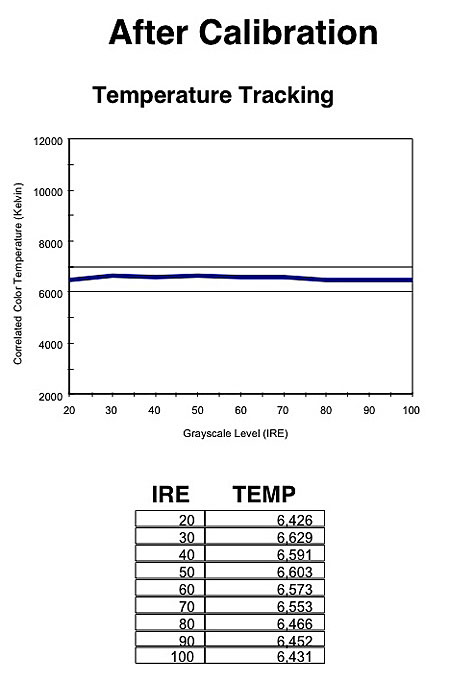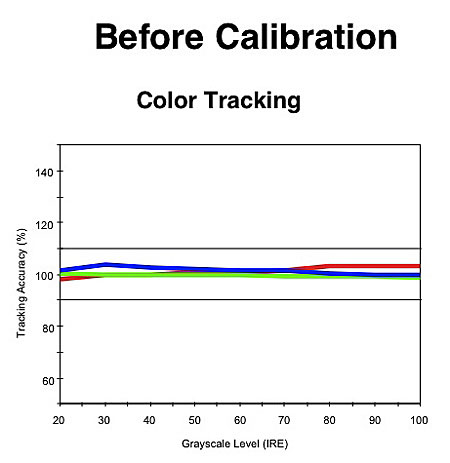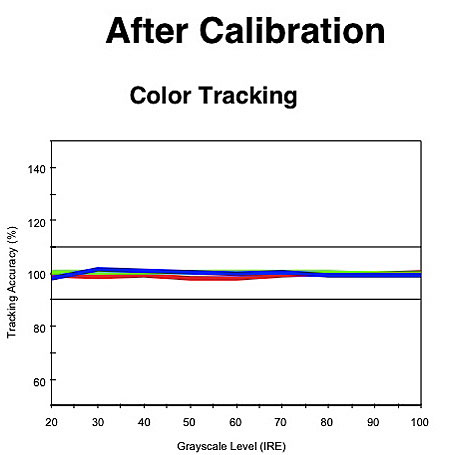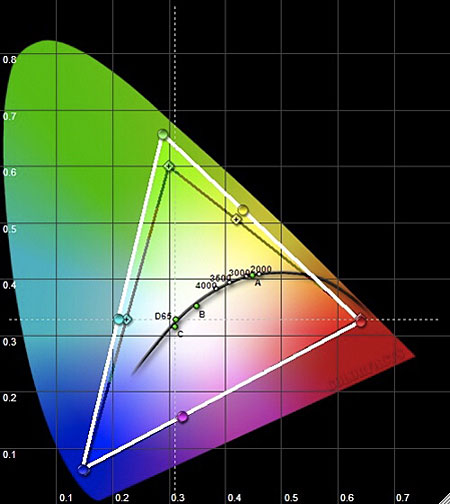Sony BRAVIA KDS-50A3000 SXRD Rear Projection Television Measurements
Summary
• The Sony KDS-50A3000 provides a good balance of overall performance characteristics, but was at its best with high-definition sources, or standard definition sources externally upconverted to 1080i/p.
• The set's color performance was close to ideal out of the box in the Warm2 color temperature setting, but was further improved after calibration. In the Normal setting the color gamut was virtually ideal.
• The peak contrast was very good, the full screen video black level satisfactory, and the overall peak contrast ratio also very good. The ANSI contrast was less impressive, but only in comparison to the readings we have obtained recently on far more expensive flat panel sets from Pioneer (plasma) and Samsung (LCD with LED backlighting and local dimming).
Details
Settings
Keep in mind that unit-to-unit sample variations, the viewing environment, and the source might render the settings we used, shown below, less than optimum on some samples. We strongly recommend that you confirm the results on your sample by using one of the many display setup DVDs that are available. This will help you to set up the user video controls correctly, and get as close as possible to an optimum picture short of a full calibration. The latter is best left to a competent and properly equipped technician, including those trained and certified by the Imaging Science Foundation (ISF).
Picture Mode: Standard
Advanced iris: Auto2
Picture: 65 to 80*
Brightness: 49
Color: 55
Hue: 50
Color Temp: Warm2
White Balance: (Warm2)
Gain: Red -4, Green 0, Blue 0
Bias: Red 2, Green 0, Blue 0
Sharpness: 10
Black Corrector: Off or Low
Film Mode: Auto1
Gamma Correction: Off or Low
Color Space: Standard
Display Area: Normal
Power Saving: On
* Setting will depend on the program material and viewing environment. See text.
All controls not listed were left in their Off, Auto, or Default settings, as applicable.
Sharpness and Resolution
With a 1080i, HDMI input the sharpness test pattern showed a well-defined, single-pixel line, though it was a hair softer than on the best, most expensive flat panel displays we've tested. The same HDMI pattern at 720p had some non-defeatable edge enhancement, even with the Sharpness control set to zero, which was more pronounced in 480p. 480i was cleaner than 480p, but only with DRC Off. The component sharpness pattern results were similar, though just a bit softer, with the small loss, most visible at 1080i.
The HDMI luma (B&W) and chroma (color) response at the maximum burst frequency of my AccuPel test pattern (37.1MHz for luma) were very good at 1080i. The luma response was also very good at 720p, but the color burst disappeared at the maximum frequency. The 480i and 480p resolutions were poor in both luma and chroma, with the topmost frequency burst patterns for those resolutions essentially missing.
Over component, the 1080i responses (both luma and chroma) were satisfactory to the top bursts, but noticeably inferior to HDMI. 720p luma response remained about the same as HDMI, while the 720p chroma response was considerably better than HDMI. Both 480i and 480p were marginal at the maximum frequency, but nevertheless better than their HDMI performance.
The 1080p luma and chroma multiburst patterns on the Spears and Munsil test disc showed very good to excellent performance out to the maximum burst frequency over HDMI.
Color
In the Warm2 color temperature setting, the Sony's pre-calibration color temperature was relatively uniform across the brightness range, and despite a slight downward trend it was relatively good (Fig.1). Calibration brought this even closer (Fig.2).

Fig.1

Fig.2
Figs.3 and 4 show that the color tracking was also good before calibration, but, again, better after. But experience suggests caution in assuming that all the samples coming off an assembly line will be as good before calibration as this one! (The same could be said for any model from any manufacturer.)

Fig.3

Fig.4
The color points on the Sony, in the Normal Color Space setting (Fig.5) produced a nearly perfectly mapped overlay of the desired color space, with merely a tiny reduction from the standard. (The white triangle outlines the Sony's Normal color space, with the primaries at the peaks of the triangle; the black triangle encloses the standard REC 709 color space.) In the Wide setting, however (Fig.6) the green is oversaturated. Some viewers will prefer the Wide setting, but it is a distortion of a source transferred in the Standard (REC 709) color space.

Fig.5

Fig.6
Contrast and Overscan
In the Auto2 Advanced Iris setting, with the lamp Power Saving On and the Contrast set to 80, I measured a peak contrast ratio of 3,971:1 (55.6 foot-Lamberts peak white, 0.014fL video black). I also measured an ANSI contrast of 275:1. While the peak contrast number is very good by today's standards (though helped more by the high output level than by the merely satisfactory black reading), that ANSI contrast number is significantly lower than the best recent displays we've tested recently. My subjective impressions of the Sony on dark scenes, however, suggest that the peak number is the most indicative of the Sony's real-world performance on most program material. Of course, if we can have it all, we want it!
With the same settings but the lamp Power Saving Off, I measured a peak contrast ratio of 3,893:1 (73.96fL peak white, 0.019fL video black).
As noted in the review, Sony's name for an overscan control on this set is Display Area, and the minimum setting is Normal. (There's also as +1 position, but it crops the image rather than overscanning it.) In Normal, overscan averaged just under 3% in 1080i and 720p, and over 4% (to a maximum of 5% at the top and bottom) in 480i and 480p—yet another reason to provide the set with a steady diet of 1080i or 1080p material as often as possible. Overscan was essentially the same for HDMI and component.





























































